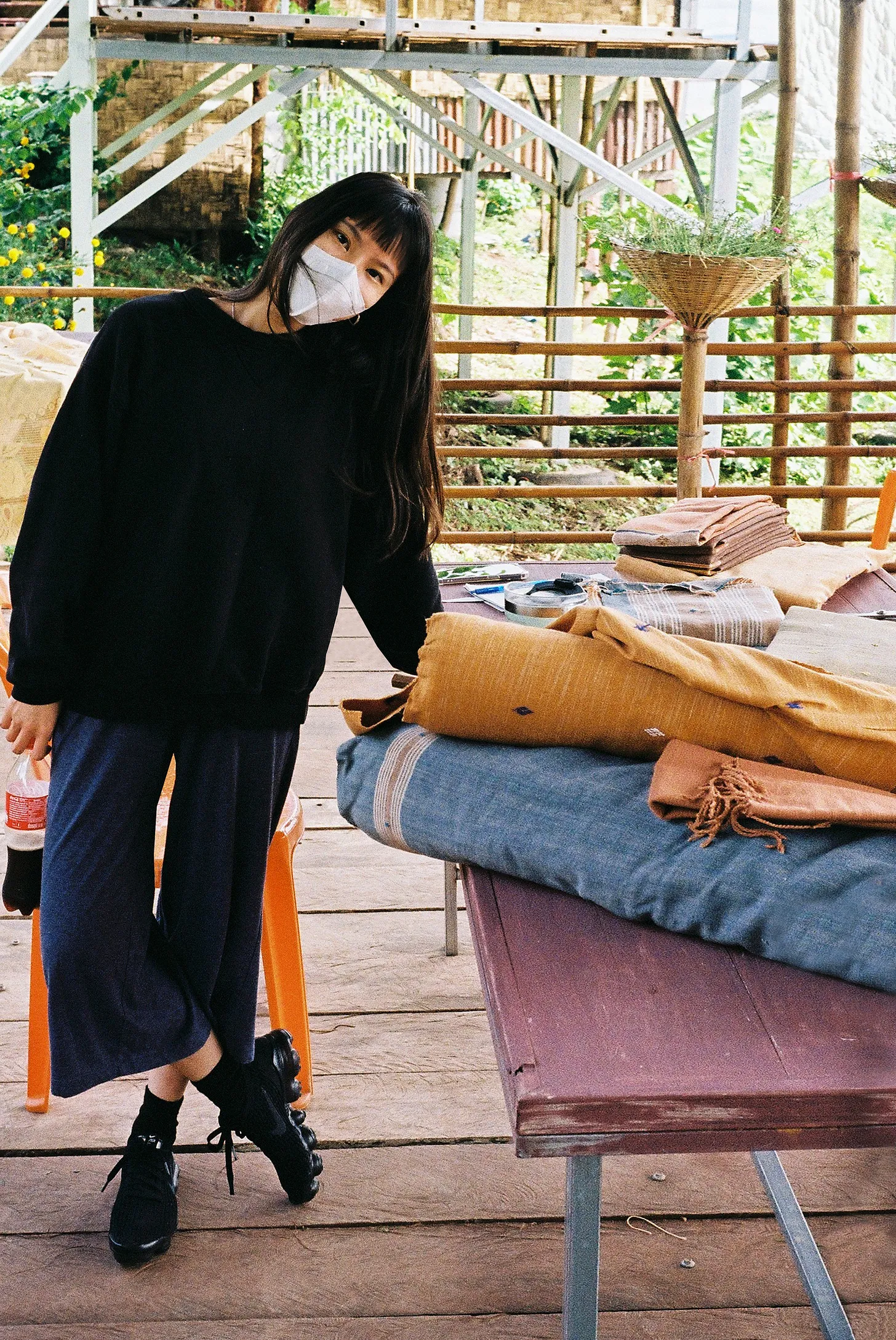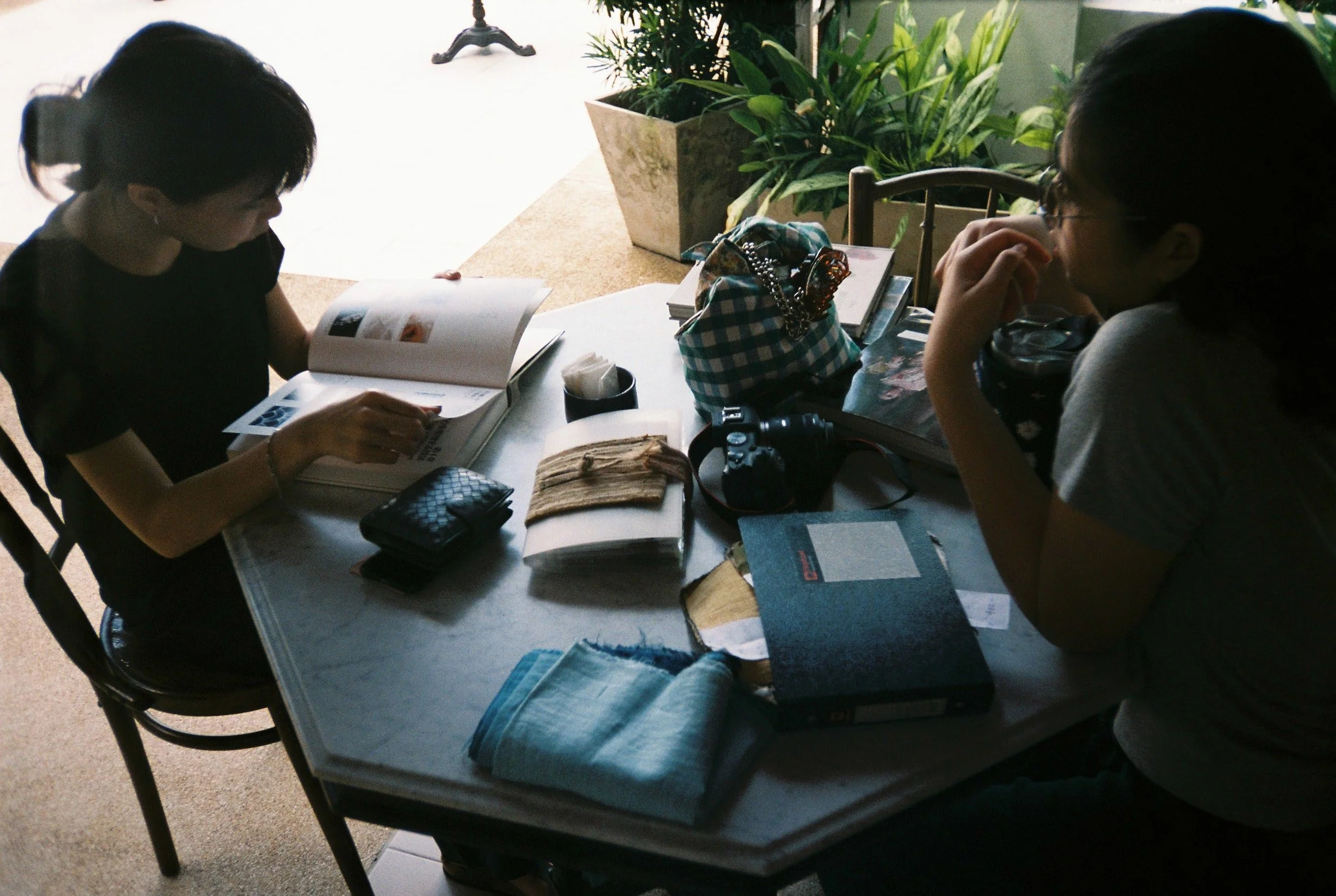Fresh Faces: Tammy Amorn of Seire Collective
Architecture, craft, and Thai heritage
Tammy Amorn, founder of Seire Collective.
Tammy Amorn’s design practice began at the intersection of architecture and a desire to understand the processes behind handcrafted objects. A graduate of the Architectural Association in London, she founded Seire Collective in 2020 during her final year of studies. Tammy sought to reinvent craftsmanship through direct collaborations with artisans across Thailand, from weavers to natural dyers. Seire Collective’s pieces, designed and tailored in her hometown of Bangkok, reflects the intersection of heritage and modernity.
In this conversation, Tammy shares how Seire Collective evolved from a research platform into a label shaped by her ongoing exploration of craft, community, and cultural continuity.
Tammy conducting research during Seire Collective’s fieldwork. Image courtesy of Seire Collective.
To start, could you talk about your background? What or who are the main influences your work draws upon?
I studied architecture at the Architectural Association in London, completing both my Bachelor’s and Master’s degrees with work experience in between. When the pandemic began in 2020, I returned to Bangkok before graduating and finished my studies online. After nearly seven years abroad, having only returned home during school breaks, I found myself reconnecting with Thailand in a new way.
With international travel restricted, I began exploring parts of the country I had not visited. A friend who ran a cotton farm introduced me to Isan, the northeastern region where I now collaborate with many makers. My background in architecture shaped how I saw these places through the lens of spatial relationships and craftsmanship. I became fascinated by how makers' environments influence their work, and this sparked a deeper interest in local supply chains. In the Mekong River region, I observed how the river irrigated cotton fields, and how the transformation of raw cotton into fabric was a collective, community-based process.
My interest in craft began during school. In my fourth year, we worked on a year-long project, and my thesis focused on weaving and craftsmanship. I studied how structural variation in textiles could relate to architectural ideas, which deepened my understanding of weaving techniques and the communities that preserve them.
In London, craft is often viewed as art. In Thailand, it is part of everyday life—practical, accessible, and rooted in community. This approach, grounded in lived experience, continues to shape how I engage with craft and design today.
A spread from one of Seire’s research files. Image courtesy of Seire Collective.
Could you describe the initial process of creating your brand, Seire Collective? What was the story behind it?
Seire started as a research platform, born in a computer lab at university. I began it with a friend, who has since returned to architecture, but at the time, we were experimenting, drawing fabric diagrams using architectural tools like Rhino and AutoCAD. Back in Bangkok, we would buy local textiles and send them to my grandmother’s tailoring shop. I would have brought the tailored pieces back to London, and people were curious—“Where is this from?” That curiosity made me reflect: these fabrics hold stories.
We began researching khao ma, a traditional woven Thai textile featuring a plaid or checkered pattern. Though Thailand was never formally colonised, the textile was shaped by histories of cultural exchange, adaptation, and indirect colonial influence. Khao ma, from the word meaning “to wrap,” inspired a collection that reinterpreted local fabrics through new forms of draping and pattern-making. We shared it casually on Instagram, and it unexpectedly gained interest.
My background in architecture made me question standardisation, efficiency, and the loss of identity. Fashion operates similarly: mass-produced, globalised, often losing cultural nuance. I became interested in how craft can resist that; how handmade objects preserve individuality and embed story. Reinterpreting traditional craft is especially vital in Southeast Asia now, as we redefine what “modern” means while staying rooted in our own context.
Behind-the-scenes images from Seire Collective’s fieldwork.
Artisans and makers of Seire Collective. Images courtesy of Seire Collective.
Seire Collective highlights traditional textile and textile-making techniques native to Thailand. I would like to talk more about the textiles that the brand uses. Are there any specific elements that you would want people to pay attention to, and why?
What drives Seire is a desire to spotlight Southeast Asian craft, which is often overlooked, especially in the West. People might recognise the region in broad strokes, but not its rich, local stories. Working with artisans, I realised craft is deeply human. As many makers move to cities, these traditions risk disappearing. Seire aims to support that community and keep their knowledge alive.
What is beautiful about craft is that it resists standardisation. Each piece is handmade, and the imperfections are part of its charm. For example, we once used Paduak bark dye, its colour changing with the seasons, making consistency impossible. But that variation tells a story.
Unlike industrial garments, handmade textiles hold memory, place, and texture. I see it as my responsibility to communicate that each bump, irregularity, or shift in colour reflects a deeper process. In embracing non-uniformity, we celebrate identity, history, and the people behind the material.
Seire Collective Edition 4. Images courtesy of Seire Collective.
Could you share more of the creative process of creating a collection in general? What are some things that inspire you?
Creating a Seire collection typically takes about a year, including prototyping and production. Inspiration tends to come unexpectedly, so I approach fieldwork without overplanning, which allows the environment to guide me. Recently, I became interested in Chinese opera after discovering an old album on Spotify. It reminded me of visiting my grandmother, sparking research into small opera communities in Thailand. These nostalgic, hyper-local moments often shape my collections.
We are now working with Indian artisans alongside Thai makers. The foundation is always craft, but lately, I have drawn more from personal anecdotes and fieldwork. When visiting weavers, I stay in their homes and observe how domestic spaces double as workspaces, such as looms built into the house, hand-layered curtains and mosquito nets. This inspired my latest collection, which explores fabric layering using Jamdani, a fine muslin suited to tropical climates.
Craft production also requires balancing rural timelines with urban demands. I work with each community based on their strengths, building long-term relationships that allow space for experimentation.
"People might recognise the region in broad strokes, but not its rich, local stories. Working with artisans, I realised craft is deeply human. As many makers move to cities, these traditions risk disappearing."
As an emerging local designer, what are some of the key challenges you face when growing your brand and equally what are the opportunities that you seek?
For me, working with craft is about embracing slowness, especially in contrast to fast fashion. As a consumer, I do not mind buying less or waiting longer for something meaningful. That mindset, however, can be challenging in regions where consumer behavior is heavily influenced by fast fashion. There is often an expectation for constant novelty such as new collections, new products. But with craft, the handmade process naturally limits the speed of production.
I see this not as a limitation, but as an opportunity to inform people and encourage a deeper understanding of what they wear. Craft connects us to the maker and the process: the fabric, the loom, the hands behind each piece. It promotes conscious consumption, which is still emerging in Thailand. While the general understanding of craft here is limited compared to other places, I believe it is growing and that part of my work is helping foster that awareness.
Seire Collective Edition 05. Images courtesy of Seire Collective.
What are your hopes for the fashion scene in Thailand, and in Southeast Asia as well?
For me, I am not sure if it is the same across Southeast Asia, but culturally, Thailand has been quite an outward-looking country. I have had this conversation with a friend before. We both studied in Bangkok and then moved to the UK, and we often talk about how being away from home for a while gives us a different perspective when we return.
I do not know if that is entirely true, but I do feel it has helped us appreciate our roots in a new way. I hope that people around my age, and even younger generations, start to look inward more—to really notice what is happening here and to find beauty in what the country already has to offer.
What I wish for is that more people open up to exploring local stories, aesthetics, and narratives. And I think it is starting to happen. People seem to be becoming more aware and appreciative of what we have.
Seire Collective’s mini patched bag.
Finally, what are your plans for your label moving forward? If you are able, could you share a bit about upcoming projects, or collections that you are working on?
I am planning to launch a new edition in a few months. It will be a smaller collection. We are also finally moving into a new studio downtown, which will double as both a showroom and a workspace. We will be based there, which is really exciting.
Looking ahead, we are expanding beyond clothing. I have been thinking a lot about how craft does not have to be limited to what we wear as it can also be part of our daily lives, like homeware and functional objects. We are gradually moving into that space as well.
If you are in Bangkok sometime soon, I would love for you to stop by! We are working on everything now, and it should all be ready by July.
Learn more about Seire Collective on their website here, and on Instagram at @seirecollective.















